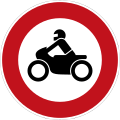Small electric vehicles regulation
| Basic data | |
|---|---|
| Title: | Ordinance on the participation of small electric vehicles in road traffic |
| Short title: | Small electric vehicles regulation |
| Abbreviation: | eKFV |
| Type: | Federal Ordinance |
| Scope: | Federal Republic of Germany |
| Issued on the basis of: | Section 6 Paragraph 1 StVG , Section 7 No. 1 PflVG |
| Legal matter: | Traffic law |
| References : | 9232-17 |
| Issued on: | June 6, 2019 ( Federal Law Gazette I p. 756 ) |
| Entry into force on: | June 15, 2019 |
| Weblink: | Small electric vehicles regulation - eKFV |
| Please note the note on the applicable legal version. | |
The miniature electric vehicles Regulation ( eKFV ) regulates the use of miniature electric vehicles (EKF) on public roads in Germany .
history
Due to the increased number of electric scooters , the federal government has drawn up an ordinance that is intended to eliminate legal uncertainty regarding participation in road traffic. The Federal Council approved this ordinance on May 17, 2019. It came into force on June 15, 2019.
A first draft of the regulation saw 2018 u. a. a helmet and driver's license and a minimum age of 16 years. Federal Transport Minister Andreas Scheuer ignored this draft.
Regulatory content
Definition of small electric vehicles
The eKFV defines that EKF are motor vehicles that have an electric drive and a design-related maximum speed of 6 to 20 km / h ( Section 1 (1) eKFV). Self-balanced vehicles (e.g. Segway i2) are expressly included. Accordingly, they may only be used on public roads in accordance with the provisions formulated in ( §§ 2 to 7 eKFV). The regulations of the StVO ( § 9 eKFV) apply to driving EKFs in road traffic . There are also the following conditions:
- There must be a handlebar or handrail (this excludes so-called hoverboards and electric skateboards )
- The nominal power must not exceed 500 watts (1400 watts if at least 60% of the power is used for balancing)
- It can be a maximum of 700 mm wide, 1400 mm high and 2000 mm long.
- The weight without the driver must be less than 55 kg.
Requirements for EKF and equipment regulations
An insurance sticker and an operating permit are required for use on public roads . Manufacturers often apply for a so-called " general operating permit " at the Federal Motor Transport Authority , so that no individual permit is required. The EKF must also be marked with a vehicle identification number and a factory plate ( § 2 eKFV). The insurance sticker must be affixed to the rear of the vehicle, if possible under the tail light. It may be inclined up to a vertical angle of 30 degrees in the direction of travel. The lower edge of the insurance sticker must be at least 50 mm above the road. Insurance stickers must be legible behind the vehicle from a distance of at least 8 m ( Section 3 eKFV).
Small electric vehicles must have the following equipment features ( §§ 4 to 7 eKFV):
- two independent brakes (if one brake fails, the other must provide at least 44% of the prescribed minimum braking power)
- Lighting (this may be removable)
- Side-mounted yellow reflectors or ring-shaped retroreflective white stripes on the tires or rims
- at least one lightening bell
A driving license is not required to drive an EKF. The minimum age for driving an EKF is 14 years ( § 3 eKFV).
There is no obligation to wear a helmet, but it is recommended to wear a helmet because of the high risk of injury.
Traffic light systems
EKF are subject to the regulation for light signals according to § 37 Abs. 2 Nr. 5 and 6 StVO ( § 13 eKFV). So in this respect you are on an equal footing with cyclists.
Use of traffic areas
Small electric vehicles , if available, must use cycle lanes or built cycle paths, regardless of whether these are mandatory for cyclists (signs 237, 240 and 241) or not ( § 10 eKFV). You are only allowed to use the lane if there is neither a cycle path nor a cycle lane. However, since vehicles generally have to use the lane ( Section 2, Paragraph 1 of the StVO), this is actually a must. It is also permitted to drive in traffic-calmed areas (which by definition have neither a sidewalk nor a lane), but only at walking pace ( Appendix 3, Section 4, No. 12 StVO).
Motorways and motorways are forbidden, as only vehicles with a design-related maximum speed of more than 60 km / h are allowed to drive there ( Section 18 (1) sentence 1 StVO). The prohibitions for all vehicles (sign 250), for motor vehicles (sign 251), for motorcycles (sign 255) and for bicycles (sign 254) also apply to small electric vehicles ( § 12 eKFV). Sidewalks and pedestrian zones are only allowed to use small electric vehicles if the additional sign " Small electric vehicles free" has been set up ( § 10 Paragraph 3 eKFV). One-way streets may only be used in the opposite direction if a cycle path is available or the additional sign “small electric vehicles free” expressly allows it.
The following traffic signs also prohibit driving in small electric vehicles:
The following additional sign allows driving with small electric vehicles; it can be placed under the sign pedestrian zone , for example .
The additional sign "Cyclists free" does not generally apply to EKF:
Insurance options
As already described, EKF are subject to compulsory insurance. This must include at least liability protection. Similar to mopeds and light motorcycles, insurance cover usually begins on March 1st. of each year and ends on 02/28 of the following year. Many insurers also offer partially comprehensive insurance contracts. With these, damage caused by external influences (such as falling rocks, hail, thunderstorms, etc.) is usually insured, as is usually the EKF battery. The costs for liability insurance are usually between € 25 and € 50 per year. The partially comprehensive insurance premiums fluctuate strongly between the insurers, this is mostly due to different insurance features.
fine
Violation of the Small Electric Vehicle Ordinance can result in fines of up to € 70. The catalog of fines is divided into two categories:
- Operating restrictions : this includes matters such as driving without an insurance sticker, and
- Behavioral requirements : this applies, for example, to violations such as driving on a prohibited traffic area.
Under certain circumstances, a violation of the law can also lead to criminal proceedings (violation of the compulsory insurance law ).
Since other regulations and laws, in particular the StVO, are not overridden ( § 9 eKFV), "normal" administrative offenses such as B. causing an accident, driving under the influence of alcohol, obstructing or endangering other road users, etc., can still be punished, even if they are not explicitly anchored in the eKFV.
Web links
Individual evidence
- ↑ Federal Law Gazette Part 1, No. 21 of June 14, 2019 Bundesanzeiger Verlag GmbH, accessed on June 14, 2019
- ↑ Simon Hage, Alexander Kühn, Guido Mingels, Emil Nefzger, Anton Rainer, Gerald Traufetter, Christian Wüst, Helene Zuber: Without helmet and understanding . In: Der Spiegel . No. 37 , 2019, pp. 60–65 ( online - September 7, 2019 ).
- ↑ Not other models because they are too wide
- ↑ a b Electric scooter / e-scooter: This applies to road traffic | ADAC. Retrieved December 3, 2019 .












